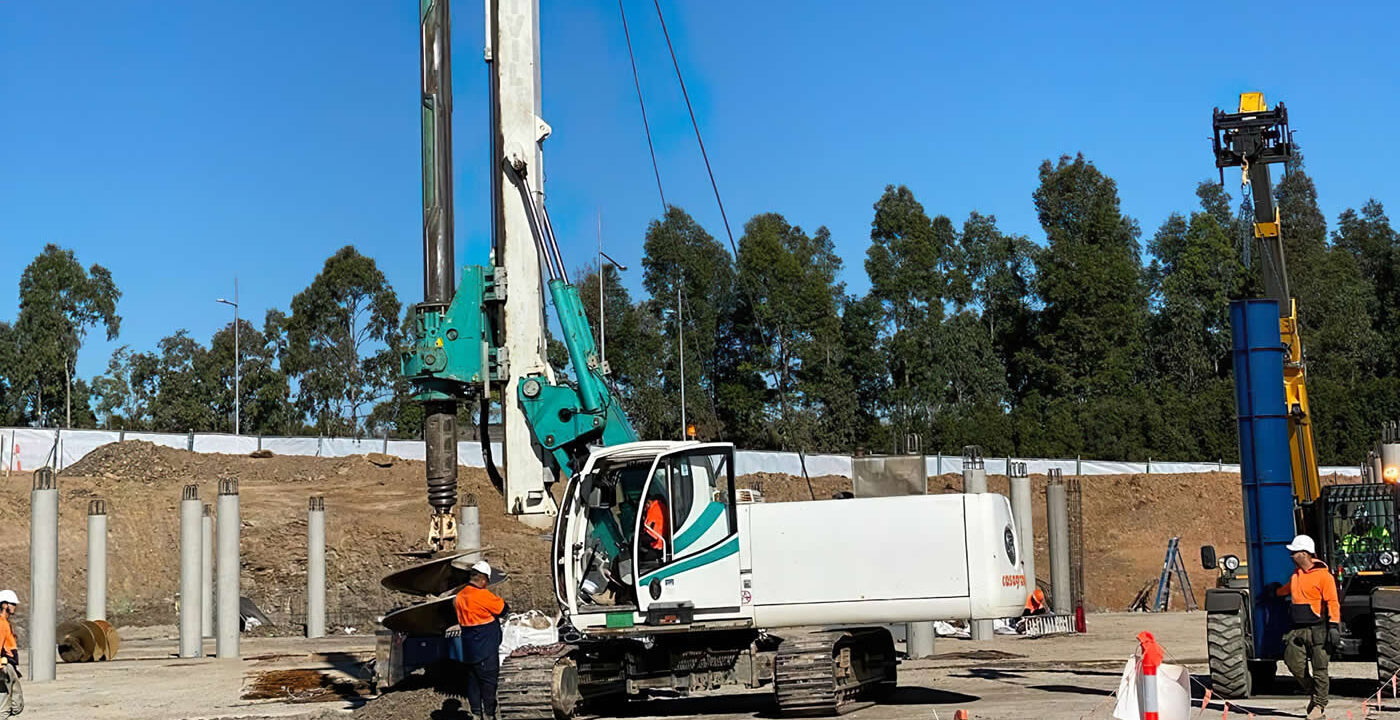All Services

Bored Piling Service in Australia: Ensuring Solid Foundations for Your Construction Projects
In the realm of construction, establishing a strong and stable foundation is essential. The foundation supports the entire structure, ensuring safety, durability, and structural integrity. Among the various foundation methods, bored piling stands out as a reliable choice. This article explores the intricacies, benefits, and significance of bored piling in Australian construction projects.
Understanding Bored Piling
What Is Bored Piling?
Bored piling, also known as drilled piers or cast-in-drilled-hole piles, is a foundation construction technique that involves drilling vertically into the ground to create a borehole. This borehole is then filled with concrete and reinforced with steel, resulting in a robust foundation support.
Types of Bored Piling
Drilled Shafts
Drilled shafts are large-diameter, deep foundation elements used for heavy structural loads. They provide excellent load-bearing capacity and are suitable for various soil conditions.
Auger Cast Piles
Auger cast piles are formed by rotating a continuous-flight auger into the ground, displacing the soil. Once the desired depth is reached, concrete is pumped through the hollow center of the auger as it is withdrawn, leaving a solid pile.
Continuous Flight Auger (CFA) Piles
CFA piles are created using a continuous auger with a hollow stem. As the auger is withdrawn, concrete is continuously pumped through the hollow stem, forming a continuous pile.
Advantages of Bored Piling
Load-Bearing Capacity
One of the primary advantages of bored piling is its remarkable load-bearing capacity. This makes it suitable for projects with heavy structural requirements, such as high-rise buildings or bridges.
Versatility
Bored piling can be adapted to various soil conditions, including those with high levels of groundwater or bedrock. This versatility makes it a viable option in diverse Australian landscapes.
Minimal Noise and Vibration
Bored piling generates less noise and vibration compared to other foundation methods, making it an environmentally friendly choice, especially in urban areas with stringent noise regulations.
When and Why Bored Piling Is Necessary
Factors Influencing Foundation Choice
The choice between different foundation methods, including bored piling, depends on several factors. In Australia, these factors may include:
Soil Conditions
Australia’s diverse geography means soil conditions can vary significantly. Bored piling is often chosen when dealing with soft or unstable soil conditions, ensuring stability and preventing settlement issues.
Heavy Structural Loads
For projects that require bearing heavy loads, such as commercial buildings or infrastructure, bored piling is a reliable choice due to its exceptional load-bearing capacity.
Seismic Considerations
In regions prone to seismic activity, like parts of Australia, a robust foundation system like bored piling can enhance a structure’s ability to withstand earthquakes.
Signs Your Construction Project Requires Bored Piling
How do you know if your construction project in Australia requires bored piling? Look out for these signs:
Soft or Unstable Soil Conditions
If your site’s soil is prone to shifting or settlement, bored piling can provide the stability needed to prevent structural damage.
Heavy Building Loads
Projects involving multi-story buildings or industrial structures should consider bored piling to ensure the foundation can support the weight.
Seismic Zones
In regions like South Australia or Victoria, which are susceptible to earthquakes, bored piling can bolster a structure’s resilience.
The Bored Piling Process
Now that we’ve laid the foundation of understanding what bored piling is and why it’s essential, let’s drill down into the piling process itself. For Australian construction projects, particularly in regions like Sydney, Newcastle, and Wollongong, where soil conditions can be diverse, having a solid grasp of the piling process is crucial.
Site Investigation and Soil Testing
Before commencing bored piling, a thorough site investigation is imperative. In Australia, this process should comply with Australian Standard AS 1726-2017, which outlines the requirements for geotechnical site investigations. The objective is to gather data on soil conditions, groundwater levels, and any potential challenges that could affect the piling process.
Soil testing, adhering to Australian Standard AS 1289 series, helps classify soil types and determine their engineering properties. Understanding the soil’s characteristics is fundamental for designing the appropriate pile dimensions and reinforcement.
Design and Engineering
Once the site investigation and soil testing are complete, the piling design and engineering phase begins. This phase adheres to Australian Standard AS 2159-2009, which provides guidelines for the design and construction of piles.
In Australia, various factors come into play during design, including load requirements, soil conditions, and seismic considerations. The design must comply with local building codes and standards, such as the National Construction Code (NCC), to ensure safety and compliance with Australian regulations.
Equipment and Machinery Used
The choice of equipment and machinery is vital for a successful bored piling operation. Australian construction sites often require specialized piling equipment, which should meet the safety and environmental standards outlined in the Work Health and Safety (WHS) Act 2011 and the Environmental Protection Act 1970.
For instance, hydraulic drilling rigs are commonly used for bored piling in Australia due to their versatility and efficiency. These machines can operate in various soil conditions, allowing for precise drilling and concrete placement.
Drilling Process
The actual drilling process involves several key steps:
Borehole Drilling
Using the chosen equipment, a borehole is drilled to the required depth. The diameter and depth of the borehole depend on the design specifications and soil conditions.
Reinforcement Installation
Once the borehole is ready, steel reinforcement bars, complying with AS 3600-2018 (Concrete Structures), are lowered into the hole. The reinforcement is crucial for providing structural strength to the pile.
Concrete Casting
High-quality concrete, meeting the requirements of AS 1379-2017 (Specification and Supply of Concrete), is then pumped into the borehole. Special attention is given to ensuring that the concrete thoroughly fills the hole, eliminating any voids or weak points.
Curing
After casting, the concrete needs time to cure properly. Proper curing practices, as defined by the AS 1012 series, are essential to achieve the desired concrete strength.
Quality Assurance in Bored Piling
Ensuring that the bored piling process meets the highest quality standards is critical. Australian regulations mandate rigorous quality assurance practices, as specified in AS 2159-2009. This includes:
Testing
Regular testing of materials, concrete strength, and pile integrity to verify compliance with design specifications.
Record Keeping
Comprehensive documentation of all phases of the piling process, including site investigations, design calculations, and construction records.
Inspections
Periodic inspections by certified inspectors to confirm that the piling work aligns with design and safety standards.
Advantages of Bored Piling Over Other Foundation Methods
When compared to alternative foundation methods, bored piling offers distinct advantages that are particularly relevant in the Australian context:
Comparative Strength and Stability
Bored piling’s load-bearing capacity is superior, making it ideal for projects in regions with variable soil conditions, like coastal areas or regions with expansive soils.
Reduced Environmental Impact
The minimal noise and vibration associated with bored piling align with Australia’s strict environmental regulations, especially in urban settings and sensitive ecosystems.
Minimal Disruption to Surrounding Areas
Bored piling minimizes disruption to neighbouring properties, traffic, and infrastructure, a crucial consideration in densely populated Australian cities.
Challenges and Considerations
While bored piling offers substantial benefits, there are challenges and considerations unique to Australian construction projects:
Environmental and Regulatory Considerations
Compliance with local environmental laws and regulations, such as those related to noise, vibration, and groundwater management, is paramount.
Safety Precautions
Adherence to WHS Act 2011 and Australian Standard AS 2550.15-2019 ensures the safety of workers and minimizes risks associated with piling operations.
Bored piling plays a vital role in constructing solid foundations for diverse Australian construction projects. By adhering to Australian standards, complying with local regulations, and addressing site-specific challenges, you can harness the full potential of bored piling for your construction ventures.
For expert guidance on bored piling and construction in Sydney consult with experienced professionals who understand the nuances of Australia’s construction landscape. TBC can provide tailored solutions to ensure your project’s success, no matter the soil conditions or structural requirements.

